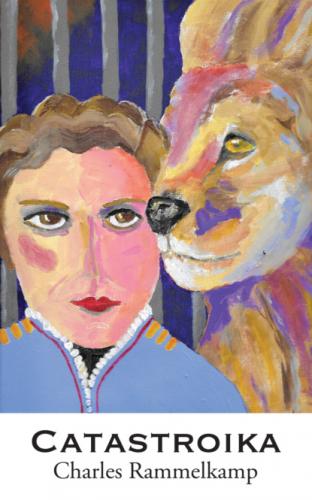Catastroika. Charles Rammelkamp
ranging from the Finnish band Turisas as a folk metal song to Boiled in Lead as a folk punk song. A Washington DC band, Ra Ra Rasputin, even takes its name from the song.
There lived a certain man in Russia long ago.
He was big and strong, in his eyes a flaming glow.
The song goes on:
Ra ra Rasputin
Lover of the Russian queen
There was a cat that really was gone
Ra ra Rasputin
Russia’s greatest love machine.
Given all this, how could I even begin to find a new angle? But as it turns out, Rasputin’s daughter Maria was no less fascinating. The only member of the family to escape Russia after the revolution, she became a cabaret dancer, a lion tamer in the Ringling Brothers’ circus, an American citizen, a Rosie-the-riveter in the American war effort during the Second World War. She also wrote several memoirs.
Half the poems in Catastroika, which covers more than a century, are in Maria’s voice, and of course her father is among the many issues she addresses. The other half are in the voice of Sasha Federmesser, a fictional Russian Jew who likewise escapes Russia during the turmoil of the early twentieth century, making his way to Baltimore. Russian anti-Semitism is another literary and historical theme.
With the United States’ complicated relationship with Russia back in the news, I hope that the historical sketch of the Russian empire portrayed in Catastroika sheds some light on a fascinating, often troubled culture.
—Charles Rammelkamp
December, 2019
Prologue: Sightseeing in St. Petersburg
The Hermitage? Are you kidding?
The Winter Palace was overwhelming,
but the modest MusEros on Ligovskiy Av.
was the high point.
Sure, we saw the Kolyvan Vase
in the west wing of the Old Hermitage,
largest vase in the world,
like a birdbath for pterodactyls,
after we’d already passed through
the Hall of Twenty Columns,
its amazing mosaic floor,
hundreds of thousands of cubed-tile tesserae;
over three million pieces of art altogether,
largest collection of paintings in the world,
founded by Catherine the Great in 1764, yes,
but the MusEros has Rasputin’s footlong dong
preserved in a glass jar,
severed from the mystic when he was murdered
a hundred years ago, in 1916.
They say just seeing it
can cure a man of impotence.
Did it work?
Maybe it was the exotic unfamiliar surroundings,
St. Petersburg so different from Davenport,
or maybe the aphrodisiac qualities of the vodka,
but when we got back to our room at the Pushka Inn,
I hadn’t felt such ardor for Alexandra
since the steamy backseat of my parents’ car
after football games on crisp Iowa evenings –
my wife’s name the same as the Romanov tsarina
rumored to be Rasputin’s lover.
SASHA
Call Me Sasha
After the “People’s Will,” a revolutionary band,
assassinated Alexander II in 1881 –
a bomb tossed in Saint Petersburg –
Jews lost most of the privileges
we’d been granted in Russia.
Alexander, the “tsar liberator,” had freed the serfs
twenty years earlier, and we’d benefited as well.
Rasputin originally praised the Black Hundreds,
the nationalist group that promoted Sergei Nilus,
the mystic who later published
The Protocols of the Elders of Zion
as a part of his work on the Antichrist.
But by 1912 he’d mellowed,
defending Jews from our detractors,
calling us “equal before God,”
which made the Black Hundreds turn on him,
mocking him for destroying Orthodox Russia
“for the Yids.”
But still, I knew better
than to pursue a friendship
with his daughter Maria,
a lovely fifteen-year-old when I first met her,
fresh to the big city from “The Sleeping Land” –
what “Siberia” means in Tatar, after all;
“The Edge” or “The End” in Ostyak.
“Alexander Federmesser,” I introduced myself,
noting my parents had named me for the tsar,
“but you can call me Sasha.”
Jewels
Papa knew Rasputin’s secretary,
Aaron Simanovich, in Kiev,
where he ran a small jewelry shop –
all Jews knew every other Jew –
but I only became aware of him
when I lived in Saint Petersburg.
Simanovich had brought his son to Rasputin,
suffering from Saint Vitus’s Dance,
Ioann, a teenager when the spasms began,
jerking like a puppet,
Pinocchio pulled by strings.
The Petersburg doctors were helpless,
so Simanovich, desperate,
brought Ioann to Rasputin,
who cured him in ten minutes,
laying his healing hands on Ioann’s head;
he never suffered from St. Vitus’ Dance again.
Simanovich had made a fortune
selling diamonds to the Tsarina’s friends,
became Rasputin’s secretary, replacing
Ivan Dobrovolsky, who, with his wife,
had been embezzling money
the petitioners brought to Rasputin.
Maria called him by her pet name,
Simochka, fond of the Jew
who’d saved her father when Khvostov,
the Interior Minister, tried to assassinate him.
Later, after the Revolution,
